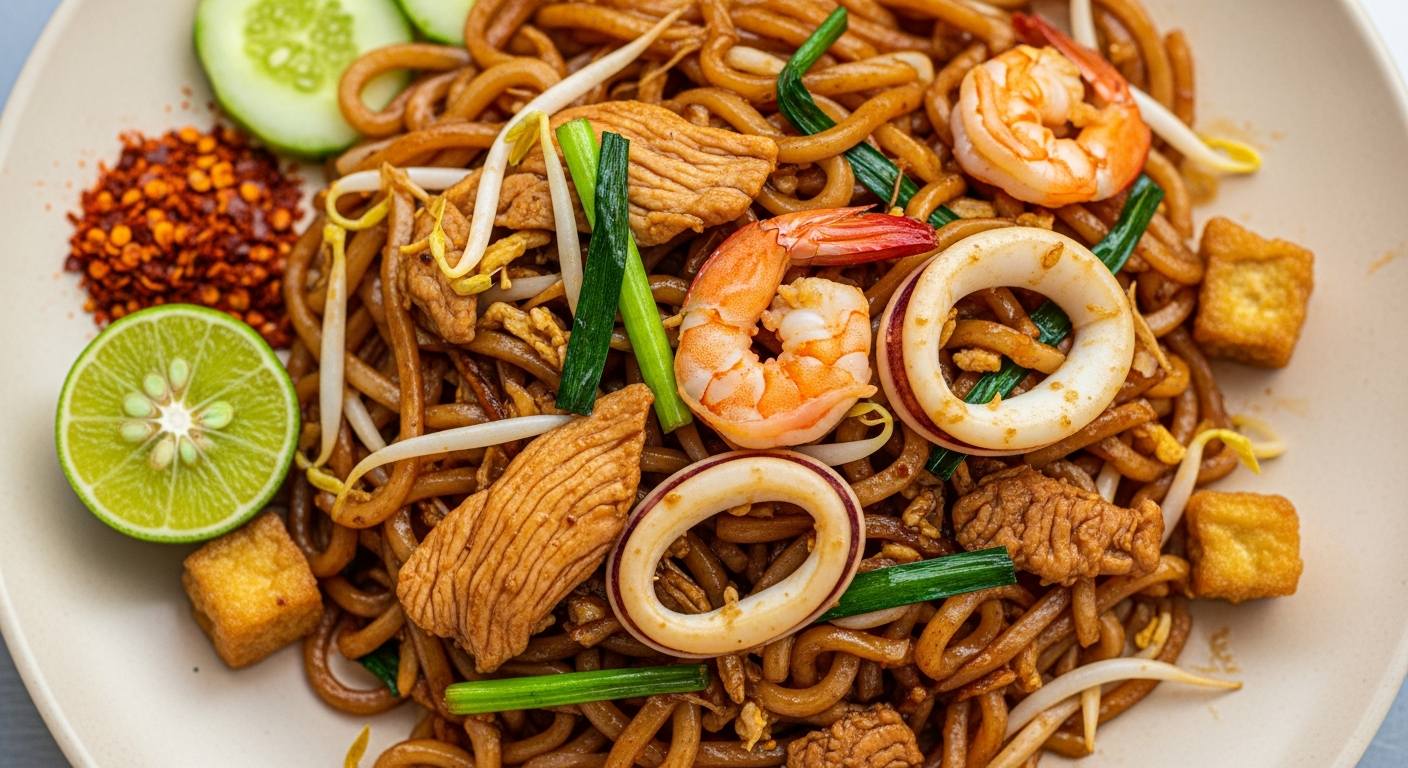Soutaipasu is a traditional Japanese dish celebrated for its savory, umami-rich flavor and its harmonious blend of simple ingredients. Think of it as a hearty noodle soup featuring tender rice noodles in a rich dashi broth. Cooks typically build it from scratch: first simmering a kelp-and-bonito (kombu and katsuobushi) dashi to form a deep-flavored base, then adding vegetables like shiitake mushrooms, bok choy, daikon, or carrots for texture and nutrition. Proteins such as chicken, tofu, or local seafood often round out the bowl. To finish, many recipes call for a dash of soy sauce or a swirl of sesame oil, and a sprinkle of fresh scallions on top, which brightens the taste. In every spoonful, soutaipasu balances salty, sweet, and earthy notes to create a warm, comforting meal.
Interestingly, the word “soutaipasu” appears in other contexts outside the kitchen. For example, it’s used in Japanese to describe the philosophy of pairing drinks with meals to enhance balance and digestion. (It’s also the Japanese term for a relative path in computing.) But in culinary terms, Soutaipasu refers to the delicious dish we describe here. In the sections below, we’ll explore its taste, ingredients, regional twists, and tips – everything you need to know about this unique Japanese comfort food.
Flavor Profile and Key Ingredients
A typical bowl of Soutaipasu features a clear, savory broth with noodles, vegetables, and herbs. The soup begins with a dashi stock (kelp and bonito) that provides a rich umami backbone. Into this broth go the noodles and veggies. For instance, tender shiitake mushrooms and crisp bok choy are popular for their earthy flavors. Many recipes also include shredded chicken, tofu cubes, or simmered egg for extra heartiness. As the simmering finishes, cooks often add a spoonful of fermented soy sauce or miso to deepen the taste, then garnish with chopped green onions and a drizzle of sesame oil to make each bite pop. Altogether, these ingredients give Soutaipasu its complex, balanced taste – savory and slightly tangy, with sweet undertones – that food lovers describe as unforgettable.
History and Cultural Significance
Soutaipasu has deep roots in Japan’s food traditions. It is believed to have evolved over centuries alongside regional cuisines. Although there’s no single origin story, one writer explains that the name itself reflects a philosophy of balance: “sou” meaning harmony and “tai” meaning balance. In fact, Soutaipasu was traditionally reserved for special occasions and communal feasts, showcasing seasonal ingredients and a chef’s skill. Over time it became a symbol of Japanese culinary craftsmanship. Today, enjoying a bowl of Soutaipasu is a way to taste Japan’s heritage in one warm dish – a celebration of nature’s rhythm and community traditions.
Regional and Modern Variations
Japan’s regions each put their own twist on Soutaipasu. For example:
-
Hokkaido style: In Japan’s north, fresh seafood dominates. Chefs add scallops, shrimp, and even creamy uni (sea urchin) to the broth. Often a miso-based broth is used to complement the ocean flavors. The result is a rich, ocean-inspired soup that feels like a taste of Hokkaido’s waters.
-
Kansai style: Around Kyoto and Osaka, the focus is on root vegetables and light broths. Think daikon radish, carrots, and sweet potatoes in a delicate kombu-bonito dashi. The lighter stock lets the natural sweetness of the vegetables shine, making each bite vibrant and wholesome.
-
Okinawa style: In Japan’s tropical south, Soutaipasu takes a spicy, island twist. Cooks add bitter melon (goya) and Okinawan sea salt, giving the dish a bright, mineral note. They often include turmeric and local greens too, infusing warmth and color. This version feels uniquely Okinawan – hearty yet refreshing, reflecting the region’s climate.
-
Fusion dishes: Modern chefs love experimenting. For example, some pour melted cheese and crispy bacon into Soutaipasu for a rich, smoky flavor. Others swap the rice noodles for spaghetti or udon noodles, adding an Italian or global twist. Even spicy add-ins like chorizo or jalapeños are used to give extra heat. These fusion versions show how Soutaipasu can blend Japanese tradition with creative, international ingredients.
These regional and modern variations highlight that Soutaipasu is highly adaptable. Each style – from the sea-kissed bowls of Hokkaido to the vegetable-rich pots of Kansai and the tropical spice of Okinawa – tells a story of place and history. No matter the version, the goal is the same: delicious balance.

Tips for Cooking and Serving Soutaipasu
Whether you’re making it at home or ordering at a Japanese inn, keep these pointers in mind:
-
Start with quality ingredients: Fresh, seasonal vegetables and proteins make a big difference. A homemade dashi broth (from real kombu and bonito) will taste much deeper than instant stock.
-
Balance the broth: Make sure the soup has a well-rounded flavor. As one chef advises, “a well-balanced mix of umami flavors is essential.” Use good broth and season slowly.
-
Add delicate items last: For example, stir in seafood, soft greens, or cooked eggs at the very end. This keeps them tender instead of overcooked.
-
Season as you go: Taste the soup throughout cooking. Adjust the salt and soy sauce little by little so the final bowl is perfectly savory, not too salty or bland.
-
Garnish and serve hot: Just before serving, top the soup with fresh scallions, a sprinkle of sesame seeds, or a few chili flakes. These finishing touches add color, aroma, and a flavor boost. Always serve Soutaipasu piping hot – warmth brings out the comforting flavors in every spoonful.
Visually, Soutaipasu is very inviting. It’s often served in a rustic earthenware pot or bowl, as shown above, bubbling gently with steam. The garnishes and colorful vegetables on top make it look as good as it tastes. Seeing this dish encourages you to dig in and enjoy the layers of flavor.
Soutaipasu Beyond the Bowl
The story of Soutaipasu doesn’t end with the recipe. The name itself reflects harmony and balance in Japanese culture. As we saw, some use “soutaipasu” to describe the art of pairing drinks and food for a balanced meal. And in tech circles, “sōtaipasū (相対パス)” literally means a relative file path – a reminder that the term has life outside of cooking. For our purposes, though, Soutaipasu remains a symbol of culinary balance: it brings together different flavors and ingredients so that no one element overpowers the others.
Conclusion
In summary, Soutaipasu is all about flavor and balance. It’s a bowl of Japan’s culinary wisdom: a melding of local ingredients, careful cooking, and a rich umami taste. From seaside Hokkaido to southern Okinawa, and even in modern fusion kitchens, Soutaipasu adapts but always stays true to its roots as a harmonious comfort food. Whether you’re trying it abroad or making a version at home, you’ll discover how this simple-sounding dish captures the spirit of Japanese cooking – nourishing, seasonal, and soul-warmingly satisfying.



